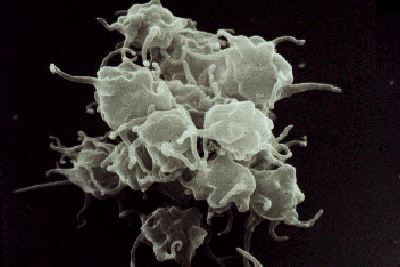ITP Publications
1. A description of ITP for patients:
ITP - What it means to you. American Family Physician (AFP), December, 1996. [Full Text]
2. The initial ITP Practice Guideline of the American Society of Hematology (ASH) remains a definitive review of the definition, diagnosis, management and outcomes of ITP in children and adults. The Practice Guideline was updated by ASH in 2011. In the third article in this group, we compared the ASH ITP guieline to an ITP guideline developed with the support of the pharmaceutical corporations who had developed new treatments for ITP; this article emphasizes the importance of potential conflicts of interest.
George, JN, Woolf, SH, Raskob, GE, Wasser J, Aledort LM, Ballem PJ, Blanchette VS, Bussel JB, Cines DB, Kelton JG, Lichtin AE, McMillan R, Okerbloom JA, Regan DH, Warrier I. Idiopathic Thrombocytopenic Purpura: A Practice Guideline Developed by Explicit Methods for The American Society of Hematology. Blood 88:3-40, 1996. [Full Text]
George JN, Vesely SK, Woolf SH. Conflicts of interest and clinical recommendations: Comparison of two concurrent clinical practice guidelines for primary immune thrombocytopenia developed by different methods. Amer J Medical Quality 2014; 29 (1): 53-60. [Full Text]
Neunert C, Lim W, Crowther M, Cohen A, Solberg L, Crowther, M. Clinical guideline on "Immune thrombocytopenia: an evidence based practice guideline developed by the American Society of Hematology." Blood 2011. [Full Text]
3. A summary of the definition, diagnosis, and management of ITP.
George JN: Definition, diagnosis, and management of immune thrombocytopenic purpura in adults. Haematologica 94: 759-762, 2009. [Full Text]
Rodeghiero F, Stasi R, Gernsheimer T, Michel M, Provan D, Arnold DM, Bussel JB, Cines DB, Chong BH, Cooper N, Godeau B, Lechner K, Mazzucconi MG, McMillan R, Sanz M, Imbach P, Blanchette V, Kühne T, Ruggeri M, George JN. Standardization of terminology, definitions, and outcome criteria in immune thrombocytopenic purpura (ITP) in adults and children. Report from an international working group. Blood 113: 2386-2393, 2009. [Full Text]
4. A systematic critical assessment of data on the incidence of ITP in children and adults (the number of patients with a new diagnosis of ITP each year), and studies to determine the prevalence of ITP (the total number of patients with ITP at a given time).
Terrell DR, Beebe LA, Vesely SK, Neas BR, Segal JB, George JN: The incidence of immune thrombocytopenic purpura in children and adults. A critical review of published reports. American J Hematol 85(3): 174-180, 2010. [Full Text]
Terrell DR, Beebe LA, Vesely SK, Neas B, Segal JB, George JN: Determining a definite diagnosis of primary immune thrombocytopenia by medical record review. Amer J Hematol 8 (9): 843-847, 2012. [Full Text]
Terrell DR, Beebe LA, Neas B, Vesely SK, Segal JB, George JN: Prevalence of primary immune thrombocytopenia in Oklahoma. Amer J Hematol 8 (9): 848-852, 2012. [Full Text]
5. To understand the current practice for management of patients with ITP, as survey of Oklahoma primary care clinicians documented the common criteria used for referral of patients with thrombocytopenia to hematologists. Another survey determined how Oklahoma hematologists (both for children and adults) manage patients with ITP. In the third article in this group, we summarized the current sequence of treatments for adults with ITP.
Terrell DR, Beebe LA, George JN, Vesely SK, Mold JW: Referral of patients with thrombocytopenia from primary care clinicians to hematologists. Blood 113: 4126-4127, 2009. [Full Text]
Lu KH, George JN, Vesely SK, Terrell DR. Management of primary immune thrombocytopenia, 2012: A survey of Oklahoma hematologists-oncologists. Amer J Med Sci 347 (3): 190-194, 2014. [Full Text]
George JN. Sequence of treatments for adults with primary immune thrombocytopenia. Amer J Hematol 87 (Suppl 1): S12-S15, 2012. [Full Text]
6. The toxicities of steroid treatment of ITP are a major problem for patients but underestimated by their hematologists. Part of the reason may be the hematologists are more concerned about the risk for serious bleeding than the patients.
Guidry J, George JN, Vesely SK, Kennison SM, Terrell DR: Corticosteroid side effects and risk for bleeding in immune thrombocytopenic purpura: patient and hematologist perspectives. European J Haematol 83: 175-182, 2009. [Full Text]
Guidry J, Watson S, George JN, Vesely SK, Terrell DR: Addendum to corticosteroid side effects in immune thrombocytopenic purpura: patient perspectives. European J Haematol 83: 497-498, 2009. [Full Text]
7. A systematic review of all case series reporting 15 or more patients that were published since 1966 and described splenectomy as treatment for ITP.
The review focuses on 3 questions: [1] Can any test or observation predict the success of splenectomy? [2] What are the risks of splenectomy? [3] What is the frequency of a durable, good response to splenectomy?
Kojouri K, Vesely SK, Terrell DR, George JN: Splenectomy for adult patients with idiopathic thrombocytopenic purpura: a systemic review to assess long-term platelet count responses, prediction of responses, and surgical complications. Blood 104: 2623-2634, 2004. [Full Text]
8. In addition to the bleeding symptoms, patients with ITP have significant problems with the quality of their lives, described by a new questionnaire designed specifically for adults with ITP. Fatigue is also a common symptom described by patients with ITP; this was documented in a survey of patients in Oklahoma and the United Kingdom, a collaboration with the UK ITP Support association.
Mathias SD, Gao SK, Miller KL, Cella D, Snyder C, Turner R, Wu A, Bussel JB, George JN, McMillan R, Wysocki DK, Nichol JL: Impact of Immune thrombocytopenic purpura (ITP) on health-related quality of life: a conceptual model starting with the patient perspective. Health and Quality of Life Outcomes 6: 13-27, 2008. [Full Text]
Newton JL, Reese JA, Watson SI, Vesely SK, Bolton-Maggs PHB, George JN, Terrell DR. Fatigue in patients with primary immune thrombocytopenia. Eur J Haematol 86: 420-429, 2011. [Full Text]
IMPORTANT!
The information included in this website is for educational purposes only. The designers and operators of this site take no responsibility for the things you may do with this information. For advice on your unique medical condition, please consult your health care professional. By going further into this website you acknowledge that you have read and understood this disclaimer.



